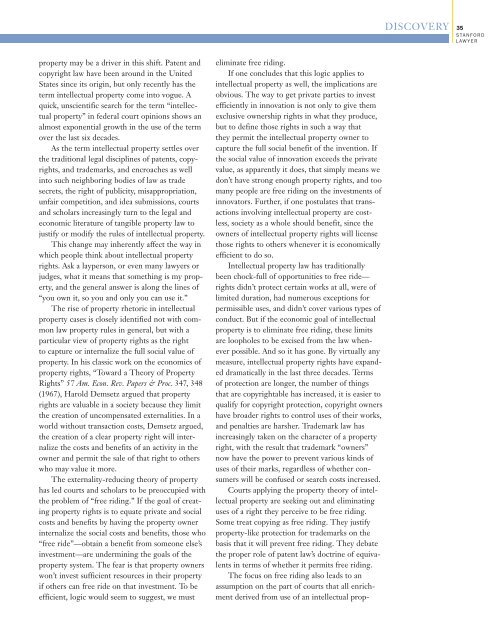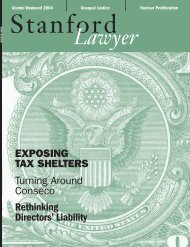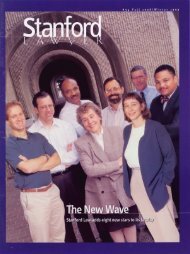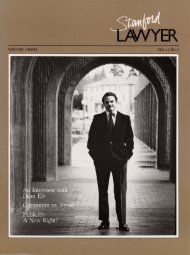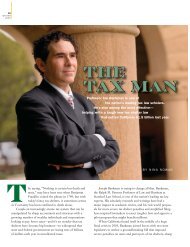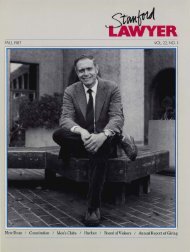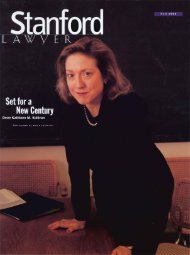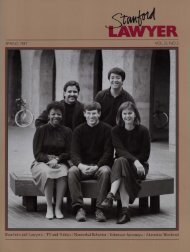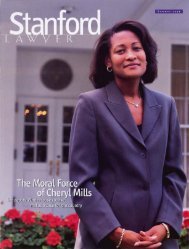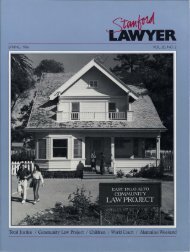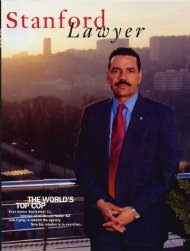Issue 73 - Stanford Lawyer - Stanford University
Issue 73 - Stanford Lawyer - Stanford University
Issue 73 - Stanford Lawyer - Stanford University
Create successful ePaper yourself
Turn your PDF publications into a flip-book with our unique Google optimized e-Paper software.
DISCOVERY<br />
35<br />
STANFORD<br />
LAWYER<br />
property may be a driver in this shift. Patent and<br />
copyright law have been around in the United<br />
States since its origin, but only recently has the<br />
term intellectual property come into vogue. A<br />
quick, unscientific search for the term “intellectual<br />
property” in federal court opinions shows an<br />
almost exponential growth in the use of the term<br />
over the last six decades.<br />
As the term intellectual property settles over<br />
the traditional legal disciplines of patents, copyrights,<br />
and trademarks, and encroaches as well<br />
into such neighboring bodies of law as trade<br />
secrets, the right of publicity, misappropriation,<br />
unfair competition, and idea submissions, courts<br />
and scholars increasingly turn to the legal and<br />
economic literature of tangible property law to<br />
justify or modify the rules of intellectual property.<br />
This change may inherently affect the way in<br />
which people think about intellectual property<br />
rights. Ask a layperson, or even many lawyers or<br />
judges, what it means that something is my property,<br />
and the general answer is along the lines of<br />
“you own it, so you and only you can use it.”<br />
The rise of property rhetoric in intellectual<br />
property cases is closely identified not with common<br />
law property rules in general, but with a<br />
particular view of property rights as the right<br />
to capture or internalize the full social value of<br />
property. In his classic work on the economics of<br />
property rights, “Toward a T heory of Property<br />
Rights” 57 Am. Econ. Rev. Papers & Proc. 347, 348<br />
(1967), Harold Demsetz argued that property<br />
rights are valuable in a society because they limit<br />
the creation of uncompensated externalities. In a<br />
world without transaction costs, Demsetz argued,<br />
the creation of a clear property right will internalize<br />
the costs and benefits of an activity in the<br />
owner and permit the sale of that right to others<br />
who may value it more.<br />
The externality-reducing theory of property<br />
has led courts and scholars to be preoccupied with<br />
the problem of “free riding.” If the goal of creating<br />
property rights is to equate private and social<br />
costs and benefits by having the property owner<br />
internalize the social costs and benefits, those who<br />
“free ride”—obtain a benefit from someone else’s<br />
investment—are undermining the goals of the<br />
property system. The fear is that property owners<br />
won’t invest sufficient resources in their property<br />
if others can free ride on that investment. To be<br />
efficient, logic would seem to suggest, we must<br />
eliminate free riding.<br />
If one concludes that this logic applies to<br />
intellectual property as well, the implications are<br />
obvious. The way to get private parties to invest<br />
efficiently in innovation is not only to give them<br />
exclusive ownership rights in what they produce,<br />
but to define those rights in such a way that<br />
they permit the intellectual property owner to<br />
capture the full social benefit of the invention. If<br />
the social value of innovation exceeds the private<br />
value, as apparently it does, that simply means we<br />
don’t have strong enough property rights, and too<br />
many people are free riding on the investments of<br />
innovators. Further, if one postulates that transactions<br />
involving intellectual property are costless,<br />
society as a whole should benefit, since the<br />
owners of intellectual property rights will license<br />
those rights to others whenever it is economically<br />
efficient to do so.<br />
Intellectual property law has traditionally<br />
been chock-full of opportunities to free ride—<br />
rights didn’t protect certain works at all, were of<br />
limited duration, had numerous exceptions for<br />
permissible uses, and didn’t cover various types of<br />
conduct. But if the economic goal of intellectual<br />
property is to eliminate free riding, these limits<br />
are loopholes to be excised from the law whenever<br />
possible. And so it has gone. By virtually any<br />
measure, intellectual property rights have expanded<br />
dramatically in the last three decades. Terms<br />
of protection are longer, the number of things<br />
that are copyrightable has increased, it is easier to<br />
qualify for copyright protection, copyright owners<br />
have broader rights to control uses of their works,<br />
and penalties are harsher. Trademark law has<br />
increasingly taken on the character of a property<br />
right, with the result that trademark “owners”<br />
now have the power to prevent various kinds of<br />
uses of their marks, regardless of whether consumers<br />
will be confused or search costs increased.<br />
Courts applying the property theory of intellectual<br />
property are seeking out and eliminating<br />
uses of a right they perceive to be free riding.<br />
Some treat copying as free riding. They justify<br />
property-like protection for trademarks on the<br />
basis that it will prevent free riding. They debate<br />
the proper role of patent law’s doctrine of equivalents<br />
in terms of whether it permits free riding.<br />
The focus on free riding also leads to an<br />
assumption on the part of courts that all enrichment<br />
derived from use of an intellectual prop-


